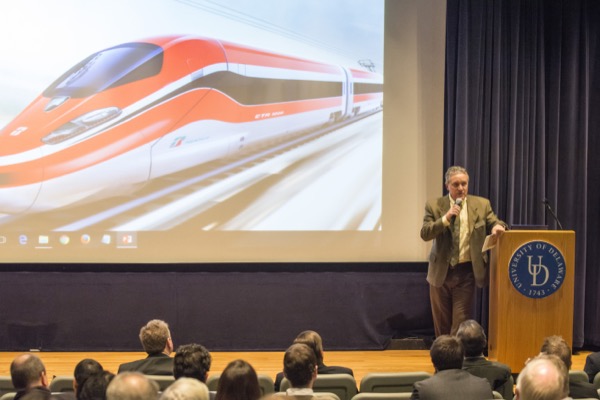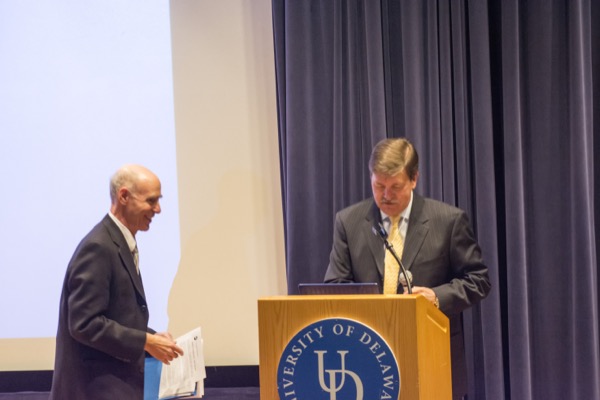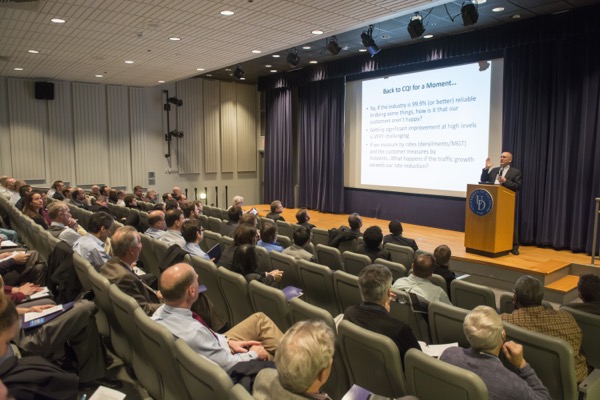


Railroad mini-conference
Converting 'mountain' of data into railroad maintenance planning information
12:04 p.m., Dec. 14, 2015--Close to 250 railway engineers, managers, economists, analysts and researchers turned out for a one-day mini-conference at the University of Delaware focused on converting the “mountain” of inspection data collected by railway systems into effective maintenance planning information.
Held at the Trabant University Center on Wednesday, Dec. 9, the second annual Big Data in Railroad Maintenance Planning Conference was organized by Allan Zarembski, professor and director of UD’s Railroad Engineering and Safety Program, and Nii Attoh-Okine, professor and big data expert.
Campus Stories
From graduates, faculty
Doctoral hooding
In welcoming the attendees, Babatunde Ogunnaike, dean of the College of Engineering, said that it is incorrect to call the early 21st century the “information age.”
“People confuse data and information,” he said. “We’re drowning in data that has to be converted into useful information to get us from the data age to the information age. Then we have to develop that information into knowledge that can make the world better.”
Keynote speaker Patrick Nowakowski, who earned his bachelor’s degree in civil engineering at UD in 1975 and is now president of the Long Island Railroad (LIRR), understands all too well how important it is to translate data into useful information that can be used to develop tools for efficient and cost-effective track and railcar maintenance, repair and replacement.
The largest and oldest commuter railroad in the U.S., the LIRR employs more than 7,000 people and serves 86 million passengers a year at 124 stations on 620 miles of track.
Nowakowski, who went to UD in the pre-electronic age when the first tool engineers learned how to use was the slide rule, now presides over an organization that collects data using video cameras, on-track engineering inspection vehicles, and such high-tech techniques as ground penetrating radar and geographic information systems.
He pointed out that data has also come to play an important role in customer service.
“We now have a tremendous demand for instant communication on the status of trains,” Nowakowski said. “People want to know what’s going on in real time, and we’re using not only electronic signs on platforms but also social media to disseminate this information.”
“Data in itself is useless,” he said in concluding his talk. “We need it to document history, predict trends, and help us prioritize and plan.”
David Staplin, retired deputy chief engineer at Amtrak and chair of the Railroad Advisory Board at UD, said that while safety and service have improved in recent years, the industry still has a long way to go.
“The key to improving service and safety going forward is that we need to be more reliable, and big data is the key to reliability,” he said. “We need better data and more data, and we need to share our data and expertise.”
The conference technical sessions addressed railroad needs from big data, big data analysis techniques, and applications and case studies.
Harry W. (Tripp) Shenton III, chair of UD’s Department of Civil and Environmental Engineering, shared information with the attendees about UD’s offerings in railway engineering, including four courses, with another one to be added next year, a graduate certificate program, short courses, and an active research program.
The conference was hosted by the Department of Civil and Environmental Engineering along with Professional Engineering Outreach at UD.
It was sponsored by the American Railway Engineering and Maintenance-of-Way Association (AREMA), the Georgetown Rail Equipment Company (GREX), Harsco Rail, Protran Technology and Ensco.
Article by Diane Kukich
Photos by Doug Baker










